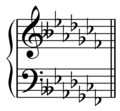- D-flat minor
-
D♭ minor 
Relative key F♭ major
enharmonic: E majorParallel key D♭ major
enharmonic: C♯ majorEnharmonic C♯ minor Component pitches D♭, E♭, F♭, G♭, A♭, B  , C♭, D♭
, C♭, D♭D-flat minor is a theoretical key based on the musical note D♭, consisting of the pitches D♭, E♭, F♭, G♭, A♭, B
 , C♭ and D♭. Its key signature has seven flats and one double flat.[1]
, C♭ and D♭. Its key signature has seven flats and one double flat.[1]Verdi's opera La Traviata, unusually, ends very decisively in D♭ minor. For clarity and simplicity, however, D♭ minor is usually notated as its enharmonic equivalent of C♯ minor, as it is, for example, in the second and third measures of Amy Beach's Canticle of the Sun.[2] Mahler's thematic motif "der kleine Appell" ("call to order") from his Fourth and Fifth Symphonies is similarly notated. In his Symphony No. 4 (first movement) it is in D♭ minor, but in his Symphony No. 5 it is in C♯ minor. In the Adagio of his Symphony No. 9 a solo bassoon interpolation following the main theme appears first in D♭ minor, returning twice more notated in C♯ minor. Likewise, in the Adagio of Bruckner's Symphony No. 8, phrases that are tonally in D♭ minor are notated as C♯ minor.[3][4][5][6]
References
- ^ Thomas Busby (1840). "D Flat Minor". A dictionary of three thousand musical terms. revised by James Alexander Hamilton. London: D'Almaine and Co.. p. 55.
- ^ Amy Beach and Betty Buchanan (2006). The Canticle of the Sun. A-R Editions, Inc.. xiii. ISBN 0895795833.
- ^ Ernst Levy (1985). A Theory of Harmony. SUNY Press. p. 62. ISBN 0873959930.
- ^ James L. Zychowicz (2005). "Structural Considerations". Mahler's Fourth Symphony. Oxford University Press. p. 28. ISBN 0198162065.
- ^ Eero Tarasti (1996). "Music history revisited". In Eero Tarasti, Paul Forsell, and Richard Littlefield. Musical Semiotics in Growth. Indiana University Press. pp. 14–15. ISBN 0253329493.
- ^ Theodor W. Adorno (1992). Mahler: A Musical Physiognomy. Translated by Edmund Jephcott. University of Chicago Press. pp. 165–166. ISBN 0226007693.
Scales and keys
Diatonic scales and keys Flats Sharps Major minor Major minor 0 C a C a 1 F d G e 2 B♭ g D b 3 E♭ c A f♯ 4 A♭ f E c♯ 5 D♭ b♭ B g♯ 6 G♭ e♭ F♯ d♯ 7 C♭ a♭ C♯ a♯ 8 F♭ d♭ G♯ e♯ The table indicates the number of sharps or flats in each scale. Minor scales are written in lower case. Categories:- Musical keys
- Minor scales
Wikimedia Foundation. 2010.

